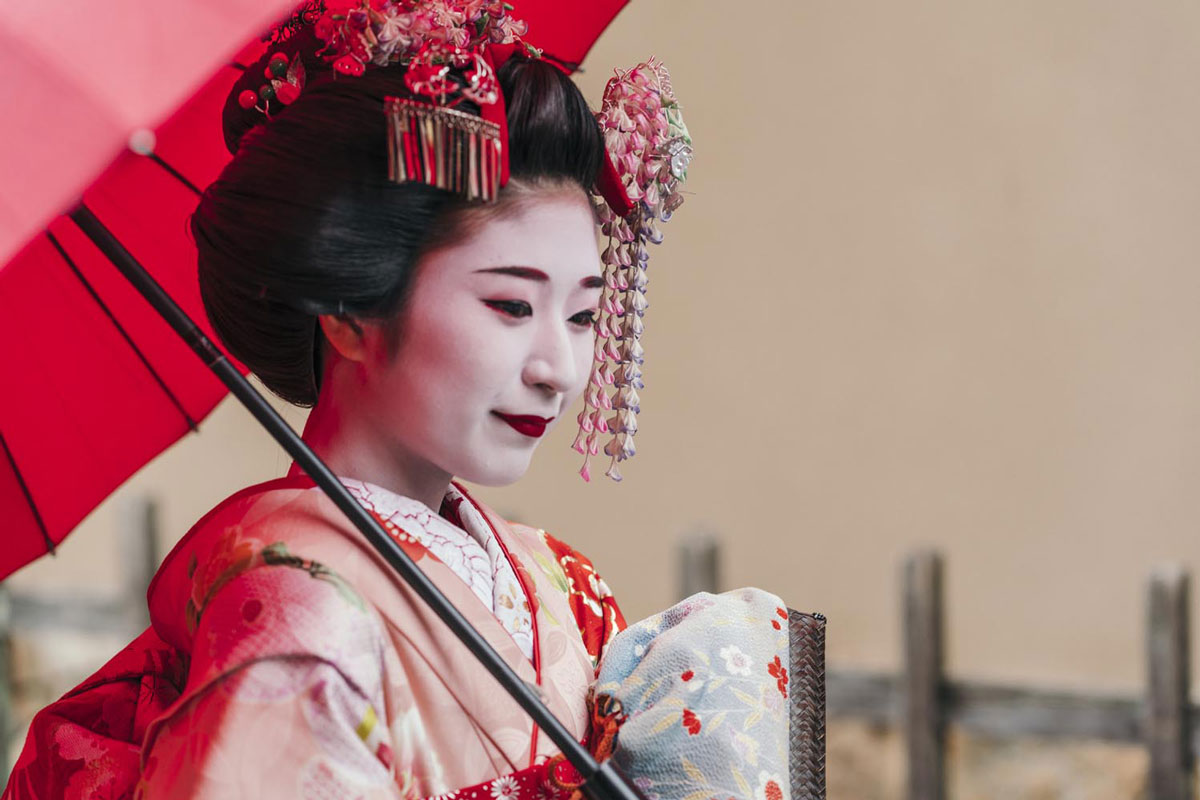

STYLE OF GEISHA – BEAUTY AND MYSTERY
Who is a geisha?
To properly understand the value of geisha, we should probably start with the meaning of the word itself. It comes from the Japanese term geisha (芸者), where gei means ‘art,’ and sha is simply ‘person.’ So the word actually means ‘a woman of art.’ However, she is not an artist in a traditional sense of the word. Especially if the less common term from the Kansai dialect is used – geiko. It means the same as geisha but applies to women trained in Kyoto – a place with the highest level of education for apprentice geisha, who are known as maiko (舞妓).
What does a geisha symbolise?
The image of a geisha has been used at a great scale – from paintings, through clothes to tatoos. She may be the embodiment of mystery, wisdom and hidden beauty. All the kimono layers worn by geisha are to separate her from reality. A geisha may be a reflection of the saying: “Do not judge the book by its cover,” and a suggestion that true beauty is on the inside.
How does a girl become a geisha?
Geisha are not made overnight. The first stage is shikomi (仕込み). For many maiko, this period is the hardest. They have to clean, scrub floors and take time-consuming dance and instrument playing lessons. Girls from Kyoto additionally learn a delicate dialect that is more sonorous that the national language. Besides, a decision to become a maiko is not easy as it means ending all contacts with the girl’s family. Apprentice geisha live in hanamachi districts in okiya (置き屋) – geisha houses.
Once a maiko masters all the skills and passes the test, she becomes a minarai (見習い), that is a legitimate inhabitant of hanamachi. This stage lasts about 30 days. During that time, the future geisha changes her looks. The metamorphosis covers mostly hair and face. The name of the candidate changes too. The ceremony of becoming a geisha involves ripping off the crimson collar, known as eri (襟), and replacing it with a white one.
What does a geisha look like?
The conspicuous image of a geisha is the outcome of many elements but mostly of hours of work. The appearance also reveals how qualified the geisha is. The longer experience, the more precise and heavier the make-up and the fuller the hairdo. A geiko hairstyle is usually a variant of a bun embellished with various accessories, such as hairpins, ribbons or combs. The women take great care of their hair and often visit a hairdresser. They paint their faces white and apply a little blusher on their cheeks. They also emphasise the line of the eye lashes and eye brows with black and claret shades.
Kimono is a traditional outfit of a geisha. It used to be the traditional clothing for all inhabitants of the Country of Cherry Blossoms. Today, it is worn in this version mostly by the Japanese women of art. The clothes of geisha are designed of expensive textiles of top quality and may weigh even 20 kg. Geiko also wear unusual footwear – okobo (おこぼ), that is women’s lacquered wooden clogs. Moving smoothly in such shoes is quite a challenge since the wedges are 10-15 cm high.
Where can you meet a geisha?
Geisha are a rare sight in the crowded streets of the Country of Cherry Blossoms. In cities, e.g. Kyoto or Tokyo, you can still encounter “flower towns” (hanamachi – 花街), geisha districts. In the local tea shops, you can watch the tea ceremony performed by the women of art. Besides, such districts have plenty of stalls and shops with various flowers, accessories, wigs or kimonos typical of geisha.
Mineko Iwasaki – the most famous geisha
Known worldwide, Mineko Iwasaki met many influential people, such as Elia Kazan, Henry Kissinger, Gucci or Elizabeth II. How did she get so far? She went to a geisha school when she was 6, she had been fascinated with dance since childhood. She was a swift learner and her skills were admired even when she was still a maiko. After the ceremony where she was promoted to a geisha, she was immensely popular and invited everywhere. She ended her career at the age of 29 by getting married.
She became internationally famous after her autobiography Geisha of Gion came out. In the book, Mineko Iwasaki depicts the world of geisha based on her own experience and shows its bright and dark sides. Her story inspired Arthur Golden to write Memoirs of a Geisha, an even more famous best-seller, later made into a film. This way the whole world could learn the incredible elements of the Japanese culture that geiko – the Japanese women of art – encounter on a daily basis.


















